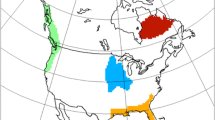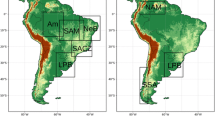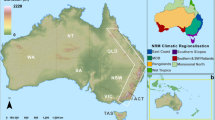Abstract
This work is a first step in the analysis of uncertainty sources in the RCM-simulated climate over North America. Three main sets of sensitivity studies were carried out: the first estimates the magnitude of internal variability, which is needed to evaluate the significance of changes in the simulated climate induced by any model modification. The second is devoted to the role of CRCM configuration as a source of uncertainty, in particular the sensitivity to nesting technique, domain size, and driving reanalysis. The third study aims to assess the relative importance of the previously estimated sensitivities by performing two additional sensitivity experiments: one, in which the reanalysis driving data is replaced by data generated by the second generation Coupled Global Climate Model (CGCM2), and another, in which a different CRCM version is used. Results show that the internal variability, triggered by differences in initial conditions, is much smaller than the sensitivity to any other source. Results also show that levels of uncertainty originating from liberty of choices in the definition of configuration parameters are comparable among themselves and are smaller than those due to the choice of CGCM or CRCM version used. These results suggest that uncertainty originated by the CRCM configuration latitude (freedom of choice among domain sizes, nesting techniques and reanalysis dataset), although important, does not seem to be a major obstacle to climate downscaling. Finally, with the aim of evaluating the combined effect of the different uncertainties, the ensemble spread is estimated for a subset of the analysed simulations. Results show that downscaled surface temperature is in general more uncertain in the northern regions, while precipitation is more uncertain in the central and eastern US.












Similar content being viewed by others
References
Alexandru A, de Elía R, Laprise R (2007) Internal variability in a regional climate model. Mon Weather Rev, in Press
Bechtold P, Bazile E, Guichard F, Mascart P, Richard E (2001) A Mass flux convection scheme for regional and global models. Q J R Meteor Soc 127:869–886
Caya D, Biner S (2004) Internal variability of RCM simulations over an annual cycle. Clim Dyn 22:33–46
Caya D, Laprise R (1999) A semi-implicit semi-Lagrangian regional climate model: the Canadian RCM. Mon Weather Rev 127:341–362
Christensen OB, Gaertner MA, Prego JA, Polcher J (2001) Internal variability of regional climate models. Clim Dyn 17:875–887
Christensen JH, Carter TR, Giorgi F (2002) PRUDENCE employs new methods to assess European climate change. EOS 83:147
Davies HC (1976) A lateral boundary formulation for multi-level prediction models. Q J Roy Meteor Soc 102:405–418
Déqué M, Marquet P, Jones RG (1998) Simulation of climate change over Europe using a global variable resolution general circulation model. Clim Dyn 14:173–189
Dessai S, Hulme M (2004) Does climate policy adaptation need probabilities? Clim Policy 4:107–128
Fiorino M (1997) AMIP II sea surface temperature and sea ice concentration observations. http://www-pcmdi.llnl.gov/projects/amip2/AMIP2EXPDSN/BCS/amip2bcs.html#Introduction
Flato GM, Boer GJ (2001) Warming asymmetry in climate change simulations. Geophys Res Lett 28:195–198
Fox-Rabinovitz MS, Takacs LL, Govindaraju RC, Suarez MJ (2001) A variable-resolution stretched-grid general circulation model: regional climate simulation. Mon Weather Rev 129:453–469
Fu CB, Wang SY, Xiong Z, Gutowski WJ, Lee DK, McGregor J, Sato Y, Kato H, Kim JW, Su MS (2005) Regional climate model intercomparison project for Asia (RMIP). Bull Am Meteor Soc 86:257–266
Gal-Chen T, Somerville RCJ (1975) On the use of a coordinate transformation for the solution of the Navier-Stokes equations. J Comput Phys 17:209–228
Giorgi F, Bi X (2000) A study of internal variability of regional climate model. J Geophys Res 105:29503–29521
Giorgi F, Francisco R (2000) Uncertainties in regional climate change prediction: a regional analysis of ensemble simulations with the HADCM2 coupled AOGCM. Clim Dyn 16:169–182
Giorgi F, Mearns LO (1999) Introduction to special section: regional climate modeling revisited. J Geophys Res 104:6335–6352
Giorgi F, Mearns LO (2002) Calculation of average, uncertainty range, and reliability of regional climate changes from AOGCM simulations via the “reliability ensemble averaging” (REA) method. J Clim 15:1141–1158
Giorgi F, Mearns LO, Shields C, McDaniel L (1998) Regional nested model simulations of present day and 2×CO2 climate over the Central Plains of the US. Clim Change 40:457–493
Goyette S, McFarlane NA, Flato GM (2000) Application of the Canadian regional climate model to the Laurentian Great Lakes region: implementation of a Lake Model. Atmos Ocean 38:481–503
Gutowski WJ, Otieno FO, Raymond AW, Takle ES, Pan Z (2004) Diagnosis and attribution of a seasonal precipitation deficit in a US regional climate simulation. J Hydrometeor 5:230–242
Han J, Roads JO (2004) US climate sensitivity simulated with NCEP regional spectral model. Clim Change 62:115–154
Hagedorn R, Doblas-Reyes FJ, Palmer TN (2005) The rationale behind the success of multi-model ensembles in seasonal forecasting—I. Basic Concept Tellus 57A:219–233
Jacob D, Podzun R (1997) Sensitivity study with the Regional Climate Model REMO. Meteor Atmos Phys 63:119–129
Jiao Y, Caya D (2006) An investigation of the summer precipitation simulated by the Canadian Regional Climate Model. Mon Weather Rev, in Press
Juang HMH, Hong SY (2001) Sensitivity of the NCEP Regional Spectral model to domain size and nesting strategy. Mon Weather Rev 129:2904–2922
Jones RG, Murphy JM, Noguer M (1995) Simulation of climate change over Europe using a nested regional-climate model. I:Assessment of control climate, including sensitivity to location of lateral boundaries. Q J R Meteor Soc 121:1413–1449
Kalnay E, Coauthors (1996) The NCEP-NCAR 40-year reanalyses project. Bull Am Meteor Soc 77:437–471
Kunkel KE, Andsager K, Liang X-Z, Arritt RW, Takle ES, Gutowski WJ, Pan Z (2002) Observations and regional climate model simulations of heavy precipitation events and seasonal anomalies: a comparison. J Hydrometeor 3:322–334
Laprise R, Caya D, Bergeron G, Giguère M (1997) The formulation of André Robert MC2 (mesoscale compressible community) model. Atmos Ocean 35:195–220
Laprise R, Caya D, Giguère M, Bergeron G, Côté H, Blanchet J-P, Boer GJ, McFarlane NA (1998) Climate and climate change in western Canada as simulated by the Canadian Regional Climate Model. Atmos Ocean 36:119–167
Laprise R, Caya D, Frigon A, Paquin D (2003) Current and perturbed climate as simulated by the second-generation Canadian Regional Climate Model (CRCM-II) over northwestern North America. Clim Dyn 21:405–421
Liang X-Z, Li L, Kunkel K (2004) Regional climate simulation of US precipitation during 1982–2002. Part I Annual cycle. J Clim 17:3510–3529
Lorant VN McFarlane N, Laprise R (2002) A numerical study using the Canadian Regional Climate Model for the PIDCAP period. Boreal Environ Res 7(3):203–210
Lucas-Picher P, Caya D, Biner S (2004) RCM’s internal variability as function of domain size. Research activities in atmospheric and oceanic modelling, WMO/TD. J Côté Ed 1220(34):7.27–7.28
Mearns L (2004) NARCCAP North American Regional Climate Change Assessment Program A Multiple AOGCM and RCM Climate Scenario Project over North America. AGU Fall Meeting, San Fransisco
Mitchell TD, Jones PD (2005) An improved method of constructing a database of monthly climate observations and associated high-resolution grids. Int J Clim 25:693–712
Moss RH, Schneider SH (2000) Uncertainties in guidance papers on the cross cutting issues of the third assessment report of the IPCC. Pachauri R, Tanaguchi T, Tanaka K (eds) World Meteorological Organisation, pp 33–51
McFarlane NA, Boer GJ, Blanchet J-P, Lazare M (1992) The Canadian climate centre second-generation general circulation model and its equilibrium climate. J Clim 5:1013–1044
Miguez-Macho G, Stenchikov GL, Robock A (2004) Spectral nudging to eliminate the effects of domain position and geometry in regional climate simulations. J Geophys Res 109:D13104
Murphy JM, Sexton DMH, Barnett DN, Jones GS, Webb MJ, Collins M, Stainforth DA (2004) Quantification of uncertainties in a large ensemble of climate change simuations. Nature 430:768–772
Noguer M, Jones RG, Murphy JM (1998) Sources of systematic errors in the climatology of a regional climate model over Europe. Clim Dyn 14:691–712
Paquin D, Laprise R (2003) Traitement du bilan d’humidité interne au MRCC. Ouranos, Simulations group, Internal report No 2, 26 pp [available from D. Paquin, Ouranos, 550 Sherbrooke st west, 19 floor, Montreal, QC, Canada H3A 1B9]
Pan Z, Christensen JH, Arritt RW, Gutowski WJ, Takle ES, Otieno F (2001) Evaluation of uncertainties in regional climate change simulations. J Geophys Res 106:17735–17751
Plummer DA, Caya D, Frigon A, Côté H, Giguère M, Paquin D, Biner S, Harvey R, de Elia R (2006) Climate and climate change over North America as simulated by the Canadian RCM. J Clim 19(13):3112–3132
Puckrin E, Evans WFJ, Li J, Lavoie H (2004) Comparison of clear-sky surface radiative fluxes simulated with radiative transfer models. Can J Remote Sens 30:903–912
Räisänen J (2001) CO2 induced climate change in CMIP2 experiments: quantification of agreement and role of internal variability. J Clim 14:2088–2104
Riette S, Caya D (2002) Sensitivity of short simulations to the various parameters in the new CRCM spectral nudging. Res Act Atmos ocean Model 32:7.39–7.40
Robert A, Yakimiw E (1986) Identification and elimination of an inflow boundary computational solution in limited area model integrations. Atmos Ocean 24:369–385
Rojas M, Seth A (2003) Simulation and sensitivity in a nested system for South America. Part II: CGM boundary forcing. J Clim 16:2454–2471
Rinke A, Marbaix P, Dethloff K (2004) Internal variability in arctic regional climate simulations: case study for the SHEBA year. Clim Res 27:197–209
Seth A, Giorgi F (1998) The effects of domain choice on summer precipitation simulation and sensitivity in a regional climate model. J Clim 11:2698–2712
Sheng J, Zwiers F (1998) An improved scheme for time-dependent boundary conditions in atmospheric general circulation models. Clim Dyn 14:609–613
Takle E, Gutowski WJ, Arritt RW, Pan Z, Anderson CJ, Silva RRD, Caya D, Chen S, Giorgi F, Christensen JH, Hong S, Juang HH, Katzfey J, Lapenta WM, Laprise R, Liston GE, Lopez P, McGregor J, Pielke RA, Roads JO (1999) Project to Intercompare Regional Climate Simulations (PIRCS): description and initial results. J Geophys Res 104:19443–19461
Tjernstrom M, Zagar M, Svensson G, Cassano J, Pfeifer S, Rinke A, Wyser K, Dethloff K, Jones C, Semmler T, Shaw M (2005): Modelling the Arctic boundary layer: an evaluation of six arcmip regional-scale models using data from the Sheba project. Boundary-Layer Meteor 117:337–381
Uppala SM, coauthors (2005) The ERA-40 re-analysis. Q J Roy Meteor Soc 131:2961–3012
Vannitsem S, Chomé F (2005) One-way nested regional climate simulations and domain size. J Clim 18:229–233
von Storch H, Zwiers FW (2001) Statistical Analysis in Climate Research. 484 pp
Verhoff A, Allen SJ, Lloyd CR (1999): Seasonal variation of surface energy balance over two Sahellian surfaces. Int J Clim 19:1267–1277
von Storch H, Langenberg H, Feser F (2000) A spectral nudging technique for dynamical downscaling purposes. Mon Weather Rev 128:3664–3673
Webster M (2003) Communicating climate change uncertainty to policy-makers and the public. Clim Change 61:1–8
Wang Y, Leung LR, McGregor JL, Lee D-K, Wang W-C, Ding Y, Kimura F (2004) Regional climate modeling: progress, challenges, and prospects. J Meteor Soc 82:1599–1628
Warner TT, Peterson RA, Treadon RE (1997) A tutorial on lateral boundary conditions as a basic and potentially serious limitation to regional numerical weather prediction. Bull Am Meteor Soc 78:2599–2617
Weisse R, Heyen H, von Storch H (2000) Sensitivity of a regional atmospheric model to a sea state dependent roughness and the need of ensemble calculations. Mon Weather Rev 128:3631–3642
Wu W, Lynch AH, Rivers A (2005) Estimating the uncertainty in a regional climate model related to initial and boundary conditions. J Clim 18:917–933
Yang Z, Arritt RW (2002) Tests of a perturbed physics ensemble approach for regional climate modeling. J Clim 15:2881–2896
Acknowledgments
The authors want to thank Claude Desrochers and Mourad Labassi for maintaining a user-friendly local computing environment at the Ouranos Consortium. We also would like to thank Dorothée Charpentier and Jillian Tomm for their help in the final formatting and editing of the manuscript. We would like to express our gratitude to the ECMWF, whose ERA40 data used in this study were obtained from the ECMWF data server. The collaboration of the Canadian Centre for Climate Modelling and Analysis (CCCma) in Victoria, BC is warmly acknowledged; without access to CCCma’s software, this project would not have been possible. René Laprise and Francis Zwiers have generously devoted time to the discussion of some sections of this manuscript. In addition, we would like to thank the three anonymous reviewers, whose suggestions contributed to improve the manuscript. This research was financially supported by the Ouranos Consortium.
Author information
Authors and Affiliations
Corresponding author
Appendix
Appendix
1.1 Root-mean-square difference as a function of sample length
In this appendix we develop a theoretical expression for the root-mean-squared difference between two average fields as a function of sample length. Usually, the variance estimator S 2 can be written as
where M is the number of elements z, and \( \ifmmode\expandafter\bar\else\expandafter\=\fi{z} \) the mean value. When M = 2, it can be rewritten as
and, using the standard definition of average value, as
If z 1 and z 2 are two-dimensional fields, we may estimate the domain variance by averaging all grid points in both i and j directions. Then, the estimated domain variance can be written as
where D is the number of grid points in the domain, and MSD is the mean-square difference in its standard definition. From here we can see that
where S D is the estimated standard deviation and RMSD the root-mean-square difference. A better estimation of S D from this relation can be obtained when variability is uniformly distributed spatially and spatial correlation is low.
As discussed by von Storch and Zwiers (2001), the variance of a sample mean \( \ifmmode\expandafter\bar\else\expandafter\=\fi{z} \) of a collection of independent and identically distributed random variables z, can be expressed as
where N is the number of members in the sample, and S 2 the variance of z. This can be interpreted as stating that the sample mean, as an estimator of the population mean, has an uncertainty that is proportional to the population variance and inversely proportional to the size of the sample.
From (6) and (7) we obtain that
which gives us a relation for the RMSD between two average fields drawn from different samples and the length of the samples. Since the RMSD is a crude estimation of the standard deviation, a departure from the function on the right-hand side is expected (particularly if the conditions of decorrelation in time and space and uniform spatial variability are far from satisfied).
Rights and permissions
About this article
Cite this article
de Elía, R., Caya, D., Côté, H. et al. Evaluation of uncertainties in the CRCM-simulated North American climate. Clim Dyn 30, 113–132 (2008). https://doi.org/10.1007/s00382-007-0288-z
Received:
Accepted:
Published:
Issue Date:
DOI: https://doi.org/10.1007/s00382-007-0288-z




